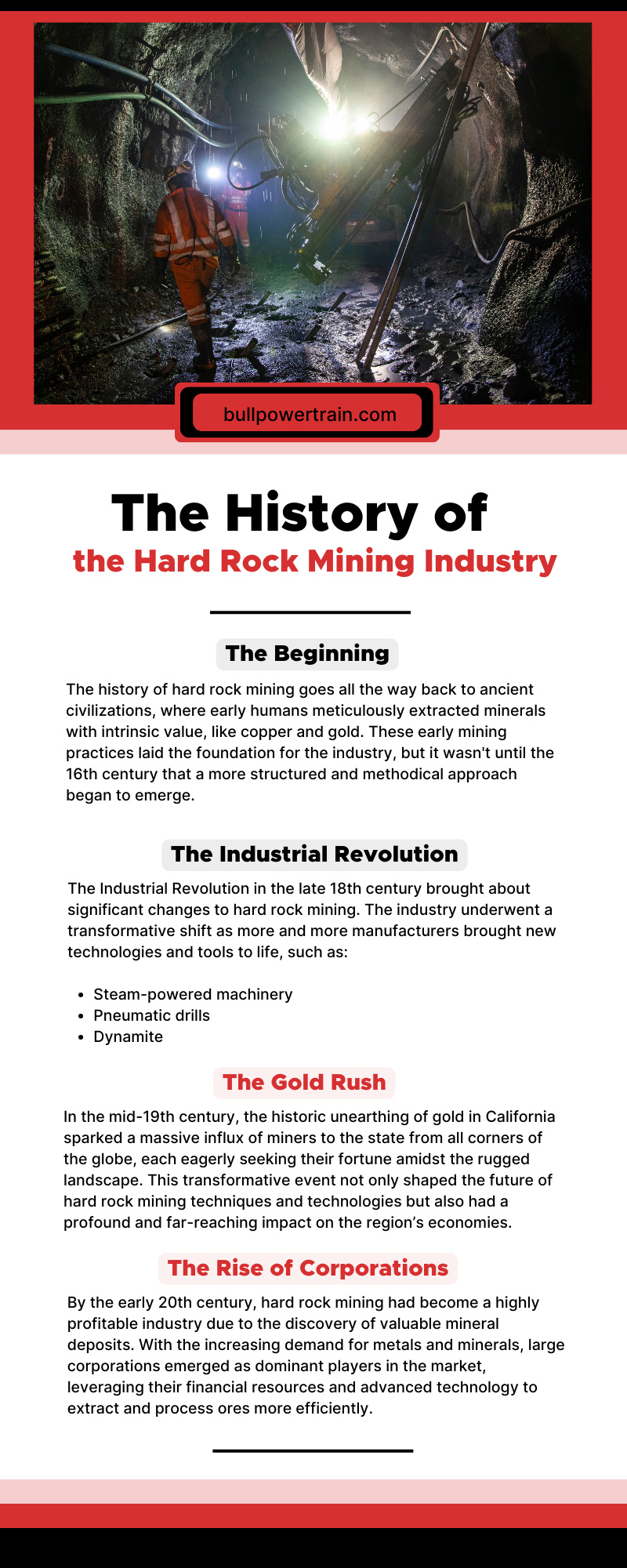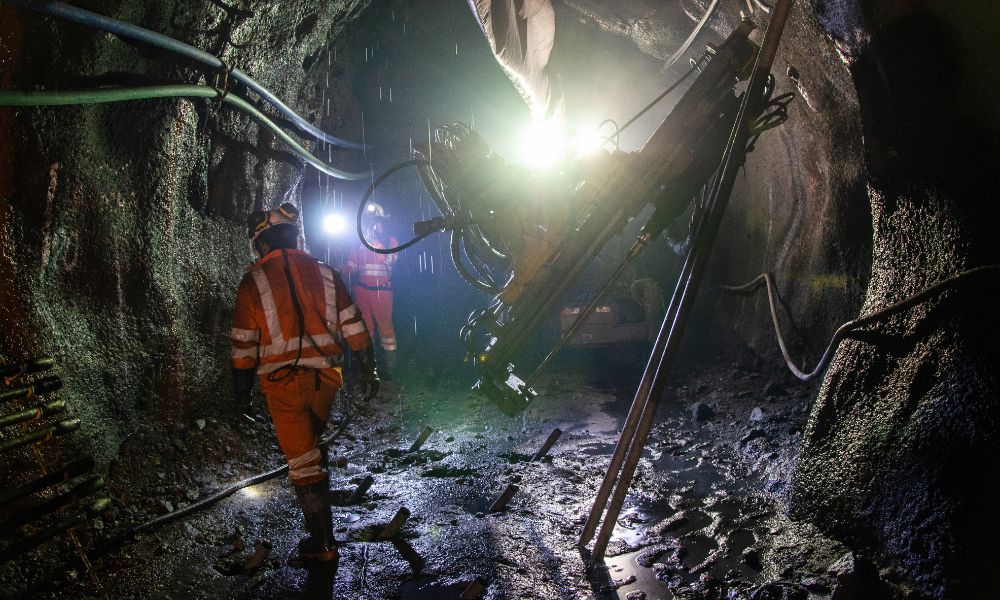From its humble beginnings in rugged terrains to the awe-inspiring achievements of modern-day innovators, hard rock mining has changed a lot in the last few hundred years. The history of the hard rock mining industry has undergone an intriguing evolution; to better understand where the industry is now and where it’s going, you must look into its past. Armed with this knowledge, you can better understand your own mining operations.
The Beginning
The history of hard rock mining goes all the way back to ancient civilizations, where early humans meticulously extracted minerals with intrinsic value, like copper and gold. These early mining practices laid the foundation for the industry, but it wasn’t until the 16th century that a more structured and methodical approach began to emerge.
As time progressed past the early stages of copper and gold mining, technology continued to advance, as did mining techniques. These advancements helped the mining industry flourish and drove economic growth for the civilizations that participated in mining. It was clear that mining operations needed to expand, something more and more civilizations capitalized on, further shaping the course of history going forward.
The Industrial Revolution
The Industrial Revolution in the late 18th century brought about significant changes to hard rock mining. The industry underwent a transformative shift as more and more manufacturers brought new technologies and tools to life, such as:
- Steam-powered machinery
- Pneumatic drills
- Dynamite
Miners now had access to more powerful and efficient equipment, allowing them to extract minerals and ores from deep within the earth with greater ease. This newfound efficiency led to increased productivity, as miners could extract larger quantities of valuable resources in a shorter period of time. The Industrial Revolution marked a shift in the hard rock mining industry, paving the way for further advancements throughout the course of mining history.
The Gold Rush
In the mid-19th century, the historic unearthing of gold in California sparked a massive influx of miners to the state from all corners of the globe, each eagerly seeking their fortune amidst the rugged landscape. This transformative event not only shaped the future of hard rock mining techniques and technologies but also had a profound and far-reaching impact on the region’s economies.
The gold rush expedited the rapid growth of towns and cities throughout the western US, the establishment of new industries to support mining operations, and the development of intricate trade and transportation networks. It forever etched its mark on the history of California and the United States, becoming an enduring symbol of the resilience, determination, and spirit of adventure that defined the era. However, the hard rock mining industry wasn’t done evolving yet.
The Rise of Corporations
By the early 20th century, hard rock mining had become a highly profitable industry due to the discovery of valuable mineral deposits. With the increasing demand for metals and minerals, large corporations emerged as dominant players in the market, leveraging their financial resources and advanced technology to extract and process ores more efficiently.
This boom of corporate power helped create a period of consolidation and control, as these corporations acquired smaller mining operations and consolidated operations to maximize profits. The concentration of power in the hands of a few corporations had significant implications for the industry, shaping the landscape of mining operations and influencing the distribution of resources.
Advancements in Machinery
As technology continued to advance at a rapid pace, the machinery used in hard rock mining underwent remarkable transformations. Groundbreaking innovations helped revolutionize the industry in profound ways, as evidenced by the development of:
- Steam-powered drills
- Sophisticated hydraulic systems
- More powerful explosives
These developments significantly boosted the efficiency of mining operations, but they also paved the way for greater safety. New tools and procedures made it easier to prioritize the safety and well-being of workers, ensuring a more secure and productive working environment.
Environmental Impact
As the demand for minerals skyrocketed, there was a corresponding surge in concerns regarding the environmental impact of hard rock mining. The utilization of toxic chemicals in the extraction process, the contamination of water sources, and the irreversible destruction of land became urgent and pressing issues warranting immediate action.
The need to find sustainable and environmentally friendly alternatives to conventional mining practices became even more imperative in order to safeguard our precious ecosystems for future generations. Thankfully, the hard rock mining industry rose to the occasion and found mining alternatives that were still efficient and more sustainable.
Regulations and Reforms
In response to growing concerns about the negative impacts of hard rock mining, governments worldwide started implementing comprehensive regulations and reforms. These measures addressed various issues, including environmental degradation and the well-being of workers.
By imposing stricter guidelines and standards, governments aimed to safeguard precious ecosystems and minimize the potential health and safety risks associated with this industry. Through these proactive measures, policymakers sought to strike a balance between sustainable resource extraction and the protection of the planet’s natural resources.
Modern-Day Mining
In today’s world, hard rock mining continues to stand as a vital pillar of the global economy, serving as the primary source of essential minerals for a wide range of industries. From construction materials to electronics manufacturing, the products of hard rock mining are integral to our everyday lives.
However, as the world embraces technological advancements and becomes more conscious of sustainability, the mining industry finds itself at the forefront of innovation and change. The mining industry is working to minimize its environmental impact through more sustainable mining practices that reduce waste and optimize resources.
Additionally, the industry is exploring new methods and technologies to enhance efficiency and safety in mining operations. Automation, robotics, and remote monitoring systems are revolutionizing mining, improving worker safety, productivity, and environmental compliance.
The Future of Hard Rock Mining
As the world progresses toward a more sustainable future, the hard rock mining industry finds itself at a critical juncture where it must confront new challenges and seize new opportunities. From embracing and implementing cutting-edge green technologies to prioritizing and addressing social responsibility, the path forward needs more innovation, adaptation, and strategic decision-making.
By navigating these new waters with foresight and resilience, the hard rock mining sector can maintain longevity and contribute to a greener and more socially conscious global economy.
From ancient civilizations to modern-day advancements, the history of the hard rock mining industry is a testament to human ingenuity and perseverance. As the world continues to rely on minerals for daily life, the job of those working in the hard rock mining industry is more important than ever, and Bull Powertrain is here to help. This is a critical industry, and if you want your operations to be efficient, you must get the components that keep your operations on track, components like high-quality off-highway brakes. At Bull Powertrain, we have the brakes you need and much more to ensure your hard rock mining operation can be productive and run smoothly for years to come.


